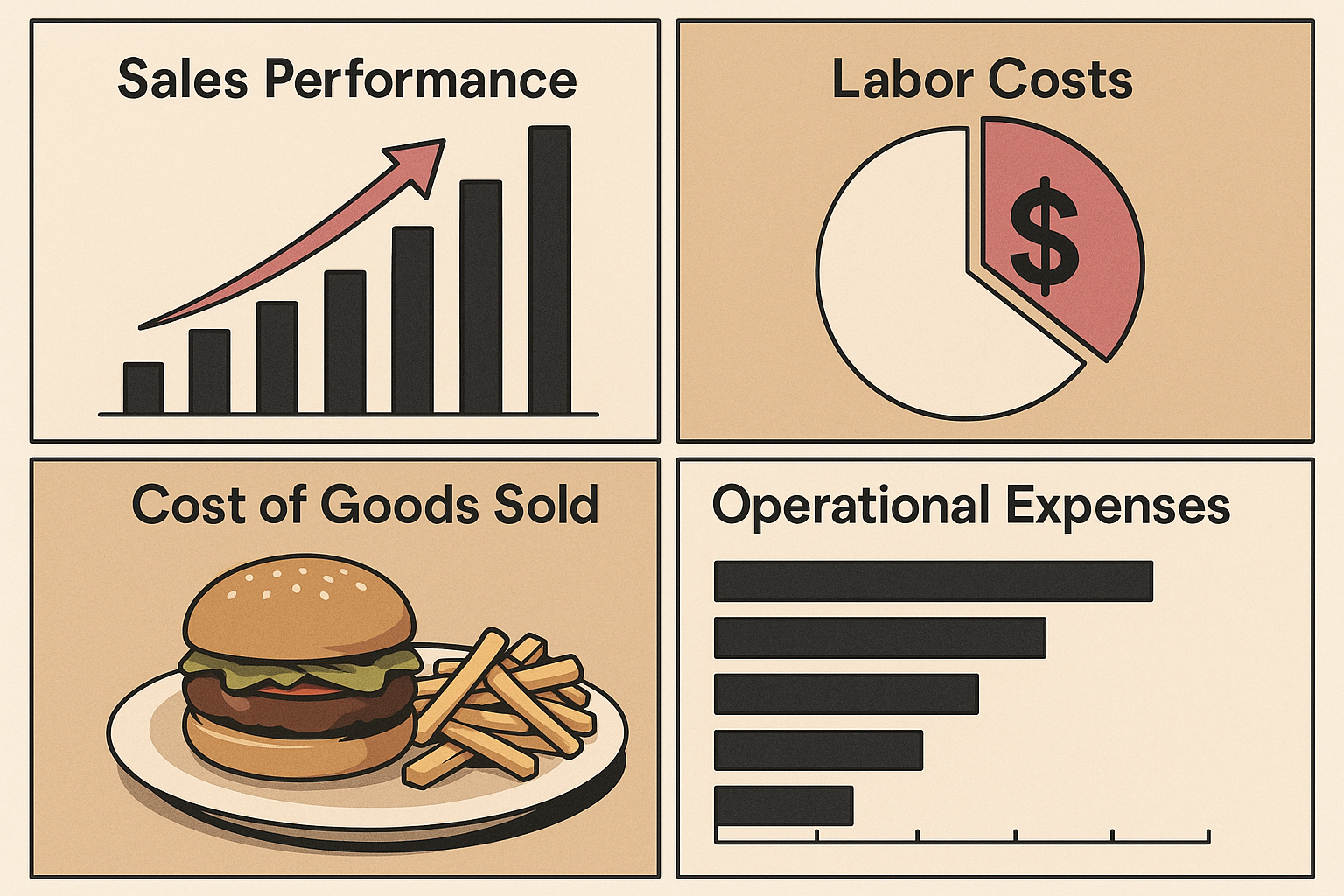
Fast Data, Smart Moves: The Role of Flash Reports in Restaurant Success
by Ariane Ramil, VP, Development
Waiting until the end of the month to review financial results can mean lost opportunities, prolonged inefficiencies, and missed chances to protect profitability. Restaurants operate in a highly dynamic environment where sales can fluctuate daily, labor costs spike unexpectedly, and inventory shrinkage eats into margins. To stay ahead, operators need timely and actionable insights that go beyond monthly financial statements. This is where Flash Reports come in.
Flash Reports are weekly—or even mid-period—financial snapshots designed to provide restaurant owners and managers with an up-to-date view of performance. By tracking key metrics such as sales, labor, cost of goods sold (COGS), and operating expenses, Flash Reports empower decision-makers to respond quickly and make adjustments before issues become unmanageable.
This article explores the value of Flash Reports, what they should include, how they guide timely decision-making, and how outsourcing accounting processes to the Philippines helps restaurant operations prepare them efficiently.
What is a Flash Report?

A Flash Report is a condensed financial report prepared on a weekly or mid-period basis that gives restaurant owners a “real-time” view of operations. Unlike full financial statements, which are prepared monthly or quarterly, Flash Reports focus on the most critical metrics that impact profitability.
The goal is not to overwhelm operators with too much detail but to deliver early warning signals and actionable data to guide daily and weekly decisions.
Key Components of a Restaurant Flash Report
For Flash Reports to be effective, they need to track the core drivers of restaurant performance. The following areas are essential:
- Sales Performance
-
-
- Weekly sales figures broken down by day and, ideally, by revenue stream (dine-in, takeout, delivery, catering).
- Sales per labor hour, which links sales to staffing efficiency.
- Comparison to budget or prior year to assess trends and seasonality.
-

Why it matters: Restaurants depend on understanding sales momentum. If weekly sales are lower than expected, operators can adjust marketing campaigns, introduce promotions, or control labor scheduling to match demand.
- Labor Costs
-
-
- Total labor cost as a percentage of sales.
- Overtime hours and labor variances.
- Front-of-house vs. back-of-house allocation for better workforce planning.
-
Why it matters: Labor is one of the largest controllable expenses in restaurants. Weekly visibility prevents creeping costs and allows management to align staffing with sales performance.
- Cost of Goods Sold (COGS)
-
-
- Food and beverage costs as a percentage of sales.
- Inventory usage vs. purchases, highlighting potential waste or theft.
- Price fluctuations on key items that affect margins.
-
Why it matters: A spike in food costs can erode profits quickly. Timely monitoring helps managers identify issues like poor portion control, excessive discounts, or supplier price increases before they spiral.
- Operational Expenses
-
-
- Key recurring expenses (utilities, supplies, marketing) allocated weekly.
- Variance analysis against expected levels.
-
Why it matters: While operational expenses don’t fluctuate as frequently as labor or COGS, sudden spikes in utilities or supply purchases can affect cash flow. Flash Reports help ensure these costs are aligned with weekly budgets.
Why Flash Reports are Critical for Decision-Making

Restaurants often operate on thin margins—sometimes less than 5%. A delay in spotting problems can lead to significant financial setbacks. Flash Reports equip owners and managers with the information they need to make proactive decisions instead of reactive ones.
Here are ways operators use Flash Reports for critical decision-making:
-
- Adjusting Labor Scheduling
If labor costs are trending above budget mid-week, managers can adjust upcoming shifts, optimize schedules, or cut unnecessary overtime before the week ends.
- Adjusting Labor Scheduling
-
- Responding to Sales Trends
If sales are dipping compared to prior weeks, owners can launch promotions, adjust menu offerings, or focus on higher-margin items to recover lost revenue. - Managing Food Costs in Real-Time
Flash Reports can reveal rising food costs, prompting immediate conversations with suppliers, revisiting portion control practices, or introducing menu adjustments. - Controlling Operational Leaks
When overhead costs rise unexpectedly, Flash Reports provide early visibility to investigate and correct issues. - Cash Flow Protection
By keeping a pulse on revenue and expenses weekly, owners can better forecast cash flow, ensuring there’s enough liquidity to cover payroll, vendor payments, and unexpected costs.
- Responding to Sales Trends
In short, Flash Reports provide the agility that restaurant owners need in a competitive environment.
How to Prepare Flash Reports Efficiently
Preparing Flash Reports requires pulling together information from multiple sources: POS systems for sales, timekeeping systems for labor, invoices for COGS, and accounting records for expenses.
Here’s a simple process to streamline preparation:
-
- Gather Weekly Sales Data
Extract data from the POS and segment by sales channels (dine-in, delivery, etc.). Compare to prior week and budget targets. - Compile Labor Costs
Sync data from scheduling or payroll systems, including wages, tips, and overtime. Calculate labor as a percentage of sales. - Track Inventory & COGS
Reconcile purchases and usage from invoices and inventory systems. Calculate COGS as a percentage of sales.
- Gather Weekly Sales Data

-
- Summarize Operational Expenses
Allocate recurring costs (utilities, rent, supplies) to the weekly report and flag unusual changes. - Prepare a One-Page Summary
The best Flash Reports are concise—usually one or two pages. Use charts or visuals to make trends easy to spot at a glance.
- Summarize Operational Expenses
The Role of Outsourced Accounting Teams in Flash Reporting

Many restaurant operators struggle to prepare Flash Reports consistently because they lack time, resources, or expertise. This is where outsourcing accounting processes to the Philippines adds immense value.
Here’s how outsourced accounting teams make Flash Reporting possible:
-
- Timely Data Consolidation
An outsourced team can pull data directly from POS, payroll, and accounting systems, ensuring Flash Reports are prepared every week without burdening managers.
- Timely Data Consolidation
-
- Standardized Report Templates
Outsourced accountants can create customized Flash Report templates that focus on a restaurant’s most critical metrics, ensuring consistency and comparability week after week. - Variance Analysis & Insights
Beyond number-crunching, outsourced teams provide analysis—highlighting why variances occurred and suggesting corrective actions. - Cost-Effective Expertise
Outsourcing to the Philippines offers access to skilled accounting professionals at a fraction of local costs, making it feasible for restaurants to maintain timely reporting without straining budgets. - Focus on Operations
With Flash Reports prepared externally, restaurant managers can focus on driving sales, improving customer service, and managing staff rather than crunching numbers.
- Standardized Report Templates
Best Practices for Maximizing Flash Reports
-
-
- Keep It Simple: Limit reports to key metrics—sales, labor, COGS, and major expenses. Too much detail reduces clarity.
- Be Consistent: Use the same format weekly to make trend analysis easier.
- Act on the Data: A Flash Report is only valuable if owners and managers take action based on the insights.
- Leverage Outsourcing: Ensure reports are prepared on time and free from errors by delegating to an experienced outsourced accounting team.
-

Conclusion
In today’s competitive restaurant landscape, agility is everything. Waiting until month-end to analyze financials is no longer enough. Flash Reports give restaurant owners real-time visibility into performance, helping them adjust labor, control food costs, and protect profitability week by week.
By outsourcing accounting processes to skilled teams in the Philippines, restaurants can ensure Flash Reports are prepared accurately and on time, without overburdening their in-house staff.
The result? Timely insights, smarter decisions, and a stronger bottom line.
For restaurant businesses looking to thrive in a fast-moving industry, Flash Reports aren’t just a nice-to-have—they’re a necessity.
For more information, please fill out the form below. We’ll circle back with you shortly to discuss your requirements in further detail.

We’d love to Meet You In Person Or Via The Web!
If you have any questions, or just want to learn more about how our services can contribute to your operation’s success, please fill out the form and we’ll respond as soon as we can. Alternatively, call us directly at (818) 888-9579.
